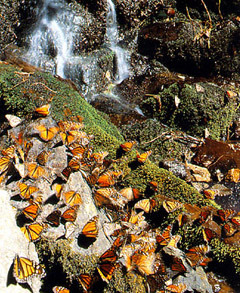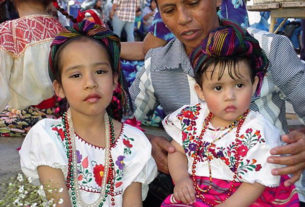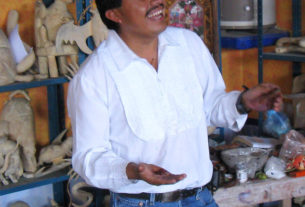Mexico experiences one of nature’s loveliest gifts each winter when billions of Monarch butterflies descend on the warm forests of the country’s central highlands.
The Monarch is known for its long migrations and this annual journey covers some 2,500 miles-from the chilly regions of Canada and the northeastern United States to the mountains of Michoacán. The resplendent yellow creatures blanket the countryside from November to March and can number as many as 4 million per acre of terrain, making the landscape look like moving clouds of gold.
Scientists believe that the migration has been going on for some 40 million years and is much like the migration of wild animals and birds in Africa. The Mexican Monarchs, however, may have been migrating for even longer. One peculiar aspect of the migration is the change that occurs in the biological processes. Sexual maturity is delayed in order to allow them to wait out the winter in Mexico, and mating begins during the journey back north.
Life on the Road
The Monarch is choosy about its roost. Their mountain sanctuaries in Mexico like, for example, at El Rosario in Michoacán, are filled with Oyamel fir trees, which are used for resting between flights and for shelter from the cold, rain and snow (they seek out an environment similar to the one they inhabit up north).
The butterflies like temperatures of around 23°C, so when a cold wind or cloud appears, they head for the nearest Oyamel to huddle together in stacks like pancakes, literally bending the tree branches with their weight. This is assumed to be the way they conserve energy. They’ll even seek out the body heat of a human being-if you stand still for a few minutes, they’ll flutter over and shamelessly perch on your head or shoulder.

There’s no greater sensory experience than listening to millions of them beating their wings to produce a collective shussssh or soft murmuring sound, which scientists call a susurrus. The overall effect of this sound reverberating through an otherwise silent pine forest is heart stopping.
The butterflies survive on pollen and milkweed (asclepia in Spanish), which protects them against predators. When the yellow plant is ingested, it produces a substance that is toxic to birds-their natural enemy. The birds learn to recognize the butterfly’s bright patterns and avoid them. The female Monarch, wisely enough, lays her eggs on the underside of the milkweed when journeying north.
The female will deposit between 200 to 300 eggs at a time, whose contents emerge as a caterpillar, then a chrysalis and finally a butterfly within a few weeks time. The newborn insects then continue the flight home. It’s believed that when autumn approaches with less hours of sunshine, the Monarch’s hormonal system changes and triggers an urge to migrate. The exodus south usually starts in September.
The Monarch’s life span is nine months, meaning that a new generation appears in Mexico each year. Some experts believe that the migration is guided by magnetic vibrations emanating from the earth, mapping out a route for the journey. A tiny chamber located at the base of the antennae contains miniscule receptors for picking up the magnetic field.
The Monarch also seems to have inspired myths and legends in pre-Hispanic Mexico. For example, the Nahuatl people believed that the Monarchs were souls of dead children returning to the home of their ancestors. The legend took on a certain degree of veracity because the Monarchs always appear en masse around Nov. 2, Mexico’s Day of the Dead celebration. The Toltecs, on the other hand, associated the butterfly with the power of the sun. A butterfly carved on the chest of a stone warrior figure can be seen at Tula, a major Toltec archaeological site outside Mexico City.
Safe Havens
The reported account of the death of millions of Monarchs caused by a severe winter a few years back inspired schoolchildren from Pennsylvania to write a book for the children of the El Rosario sanctuary in Michoacán who were mourning the loss.
In fact, it was the El Rosario children who first brought the protection of the sanctuary to the attention of the government in the 1980s. The sanctuaries have always been and still are threatened by loggers, who prize the stately coniferous trees that shelter the butterflies. The children were ready to march to Los Pinos in protest against the forest’s decimation, which prompted government officials to create the Monarch sanctuaries in 1986. To date, there are 11 sanctuaries, the majority located in Michoacán. Former President Ernesto Zedillo granted more land to the El Rosario sanctuary before he left office.
The La Cruz Habitat Protection Project, whose main focus is to reforest the reserves, was also founded in response to the dwindling forest reserves of the Michoacán sanctuaries. More than 500,000 seedlings have been planted since the program began five years ago. The project works closely with the non-profit Michoacán Reforestation Fund based in Alameda, California that also aims to help the inhabitants of the area establish a sustainable forestry program and direct them towards other sites for forest products.
The Monarch butterflies set out for their summer homes around the Spring Equinox on March 21. The townsfolk of Angangeo will tell you that on this day the butterflies literally flood the streets in a final despidida to their Mexican friends as their sojourn draws to a close.
How to get there … where to stay … what to do
Two of the butterfly sanctuaries-El Rosario and Sierra Chincua-are open to the public. The one easiest to get to from Mexico City is El Rosario, located near the town of Angangeo-almost a four hour drive from Mexico City. You can travel to Angangeo by bus via the Autobuses Occidente bus line from the Observatorio terminal-but it takes three separate buses to get you there and you’ll have to leave early in the morning to reach the sanctuary before it closes. Travel agencies such as Grey Line (Tel: (55) 5208-1163 have day tours, which leave at 8 a.m. in the morning, returning at 8:30 p.m. at night.
By car, take the highway from Mexico City west to Toluca and then veer off towards Zitácuaro. After Toluca, the countryside turns into fallow fields waiting to be planted with corn. The landscape is dotted with lakes, dusty villages, grazing sheep and goats, and the occasional farmer on horseback. As you get closer to the line dividing the State of Mexico from Michoacán, the landscape shifts to pine forests. The majestic sierra can be viewed through the trees, giving you a glimpse of what’s to come. As I crossed over into Michoacán, I was reminded of the Tarascans, the original inhabitants of this land. They were a proud group that refused to be conquered by the Spanish, and today their descendants produce some of Mexico’s most outstanding handicrafts.
Once arriving in Zitácuaro, in the heartland of Mexico, the climate changes to a warm semi-tropical pleasantness, which partially explains the rich farmland of the area. Hooking up with highway 15, head out of Zitácuaro to the village of San Felipe de los Alzati. Then catch the marked road for Ocampo, which takes you directly to El Rosario. Or if you wish to stay overnight near the reserve, from San Felipe de los Alzati, follow the signs to Angangueo, a pretty little town filled with flowers and a Gothic church.
From here, it’s a very short distance to the entrance of the sanctuary. A couple of other good bets are the Albergue Don Bruno in Angangueo (Tel.: 715-156-0026), a small, rustic inn, which was the first in the area to welcome lodgers, or the Villa Monarca Inn in Zitácuaro (Tel.: 715-153-5350). (While in Michoacán, don’t forget to pick up some of its famous candied fruit swirls and fabulous cajeta to take home).
Take comfortable walking shoes and plenty of water since the top of the mountain is a steep, two-kilometer climb. The top is where most of the Monarchs are congregated in groves and where you’ll want to be.
Since the altitude is 10,000 feet, it’s not recommended for people with heart problems or who are in poor physical condition because the climb can be strenuous. People with these conditions can still enjoy the sanctuary by staying lower down the mountain near the entrance, which is filled with swarms of butterflies, (although not in such concentrated numbers as at the top) and gift and snack shops.
In late winter and early spring, the butterflies congregate closer to the entrance, so you don’t have to walk as far to reach them. Volunteers who live in the area man the gift and snack shops and work as unofficial park rangers to make sure there’s no littering, smoking, or loud music. The entrance fee is US$2 (plus a tip to the guide), and hours are 9 a.m. to 5 p.m. daily. The sanctuary gets crowded on weekends, so for more solitude visit during the week.
The Sierra Chincua sanctuary opened in 1997 and is a short distance from Angangueo. Visitors to this pristine reserve can go horseback riding on the rough trails. In any case, one of the best times to visit the sanctuaries is in February when Ocampo and Zitácuaro celebrate the Festival de la Marisposa Monarca with traditional dances, music, food and a handicrafts market.


